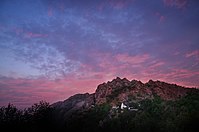Climate of Rajasthan
This article needs additional citations for verification. (December 2017) |


The Climate of Rajasthan in northwestern India is generally arid or semi-arid and features fairly hot temperatures over the year with extreme temperatures in both summer and winter.
History[edit]
This section does not cite any sources. (April 2018) |
Under the Köppen climate classification the greater part of Rajasthan falls under Hot Desert (BWh) and remaining portions of the state falls under Hot Semi Arid (BSh); the climate of the state ranges from arid to semi-arid. Rajasthan receives low and variable rainfalls and thereby is prone to droughts. As Rajasthan is the dry and hot state, Unbelievable hailstorm covered Nagaur, Rajasthan in a thin snow-like icy blanket in December 2019. Later on, it is clarified that this is not a snowfall but a hailstorm, endorse by western disturbances. The climate has changed in winters like never before.[1]
Seasons[edit]
This section does not cite any sources. (April 2018) |
Summer[edit]
Due to the Desert Geography, frequently climb above 40 to 45 degrees Celsius in most places.
Due to its location, summers are the longest season in Rajasthan.
In this time tourist activities are very low.
Winter[edit]
The cold weather commences early in October and ends around the end of February and sometimes the temperatures reach nearly 2-degree celsius [*record in 1964 in JAIPUR the temperature reached 0-degree Celsius on 13 December.]
.
Monsoon[edit]
The state has two distinct periods of rainfall: rainfall due to the South-West Monsoon after summer and rainfall due to Western Disturbances.
Temperature[edit]
| Winter (Jan - Feb) |
Summer (Mar – May) |
Monsoon (Jun – Sep) |
Post-monsoon (Oct – Dec) |
Year-round | |||||||||
|---|---|---|---|---|---|---|---|---|---|---|---|---|---|
| Jan | Feb | Mar | Apr | May | Jun | Jul | Aug | Sep | Oct | Nov | Dec | Avg | |
| Jaipur(Highest)[2] | 22.4 | 25.0 | 31.0 | 37.1 | 40.3 | 39.3 | 34.1 | 32.4 | 33.8 | 33.6 | 29.2 | 24.4 | 31.9 |
| Jaipur(Lowest)[2] | 08.4 | 10.8 | 16.0 | 21.8 | 25.9 | 27.4 | 25.8 | 24.7 | 23.2 | 19.4 | 13.8 | 9.2 | 18.8 |
Precipitation[edit]
| — | Winter (Jan – Feb) |
Summer (Mar – May) |
Monsoon 1 (Jun – Sep) |
Monsoon 2 (Oct – Dec) |
Year-round | ||||||||
|---|---|---|---|---|---|---|---|---|---|---|---|---|---|
| City | Jan | Feb | Mar | Apr | May | Jun | Jul | Aug | Sep | Oct | Nov | Dec | Total |
| Jaipur[2] | 7.0 | 10.6 | 3.1 | 4.9 | 17.9 | 63.4 | 223.3 | 205.9 | 66.3 | 25.0 | 3.9 | 4.2 | 637.4 |
Disasters[edit]
Drought and famine[edit]
Rajasthan receives low and variable rainfalls and thereby is prone to droughts. Availability of water is less due to the absence of rivers and lakes.
Floods[edit]
Occasional floods in cities due to improper drainage occurs. Sometimes floods also occur in western Rajasthan due to impervious base rocks.
Pollution[edit]
In some industrial and urban centers pollution has been reported occasionally.
See also[edit]
References[edit]
- ↑ https://www.india.com/news/india/watch-is-it-snowing-in-rajasthan-mind-boggling-video-goes-viral-on-twitter-3878755/
- ↑ 2.0 2.1 2.2 "Jaipur Climatological Table Period: 1971–2000". India Meteorological Department. Archived from the original on April 2, 2015. Retrieved March 30, 2017.


